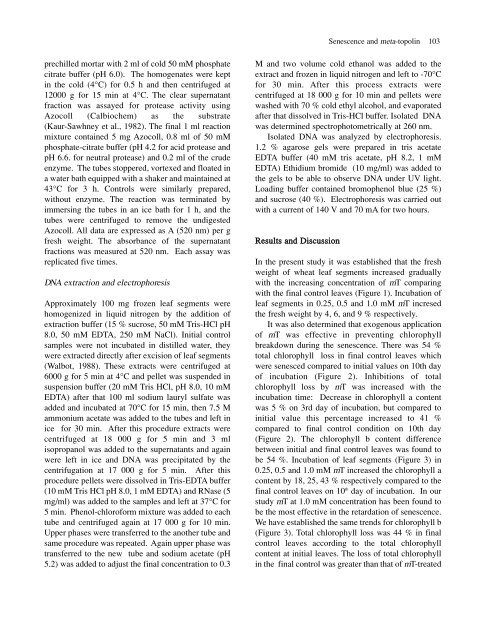Full Journal - Journal of Cell and Molecular Biology - Haliç Üniversitesi
Full Journal - Journal of Cell and Molecular Biology - Haliç Üniversitesi
Full Journal - Journal of Cell and Molecular Biology - Haliç Üniversitesi
Create successful ePaper yourself
Turn your PDF publications into a flip-book with our unique Google optimized e-Paper software.
prechilled mortar with 2 ml <strong>of</strong> cold 50 mM phosphate<br />
citrate buffer (pH 6.0). The homogenates were kept<br />
in the cold (4°C) for 0.5 h <strong>and</strong> then centrifuged at<br />
12000 g for 15 min at 4°C. The clear supernatant<br />
fraction was assayed for protease activity using<br />
Azocoll (Calbiochem) as the substrate<br />
(Kaur-Sawhney et al., 1982). The final 1 ml reaction<br />
mixture contained 5 mg Azocoll, 0.8 ml <strong>of</strong> 50 mM<br />
phosphate-citrate buffer (pH 4.2 for acid protease <strong>and</strong><br />
pH 6.6. for neutral protease) <strong>and</strong> 0.2 ml <strong>of</strong> the crude<br />
enzyme. The tubes stoppered, vortexed <strong>and</strong> floated in<br />
a water bath equipped with a shaker <strong>and</strong> maintained at<br />
43°C for 3 h. Controls were similarly prepared,<br />
without enzyme. The reaction was terminated by<br />
immersing the tubes in an ice bath for 1 h, <strong>and</strong> the<br />
tubes were centrifuged to remove the undigested<br />
Azocoll. All data are expressed as A (520 nm) per g<br />
fresh weight. The absorbance <strong>of</strong> the supernatant<br />
fractions was measured at 520 nm. Each assay was<br />
replicated five times.<br />
DNA extraction <strong>and</strong> electrophoresis<br />
Approximately 100 mg frozen leaf segments were<br />
homogenized in liquid nitrogen by the addition <strong>of</strong><br />
extraction buffer (15 % sucrose, 50 mM Tris-HCl pH<br />
8.0, 50 mM EDTA, 250 mM NaCl). Initial control<br />
samples were not incubated in distilled water, they<br />
were extracted directly after excision <strong>of</strong> leaf segments<br />
(Walbot, 1988). These extracts were centrifuged at<br />
6000 g for 5 min at 4°C <strong>and</strong> pellet was suspended in<br />
suspension buffer (20 mM Tris HCl, pH 8.0, 10 mM<br />
EDTA) after that 100 ml sodium lauryl sulfate was<br />
added <strong>and</strong> incubated at 70°C for 15 min, then 7.5 M<br />
ammonium acetate was added to the tubes <strong>and</strong> left in<br />
ice for 30 min. After this procedure extracts were<br />
centrifuged at 18 000 g for 5 min <strong>and</strong> 3 ml<br />
isopropanol was added to the supernatants <strong>and</strong> again<br />
were left in ice <strong>and</strong> DNA was precipitated by the<br />
centrifugation at 17 000 g for 5 min. After this<br />
procedure pellets were dissolved in Tris-EDTA buffer<br />
(10 mM Tris HCl pH 8.0, 1 mM EDTA) <strong>and</strong> RNase (5<br />
mg/ml) was added to the samples <strong>and</strong> left at 37°C for<br />
5 min. Phenol-chlor<strong>of</strong>orm mixture was added to each<br />
tube <strong>and</strong> centrifuged again at 17 000 g for 10 min.<br />
Upper phases were transferred to the another tube <strong>and</strong><br />
same procedure was repeated. Again upper phase was<br />
transferred to the new tube <strong>and</strong> sodium acetate (pH<br />
5.2) was added to adjust the final concentration to 0.3<br />
M <strong>and</strong> two volume cold ethanol was added to the<br />
extract <strong>and</strong> frozen in liquid nitrogen <strong>and</strong> left to -70°C<br />
for 30 min. After this process extracts were<br />
centrifuged at 18 000 g for 10 min <strong>and</strong> pellets were<br />
washed with 70 % cold ethyl alcohol, <strong>and</strong> evaporated<br />
after that dissolved in Tris-HCl buffer. Isolated DNA<br />
was determined spectrophotometrically at 260 nm.<br />
Isolated DNA was analyzed by electrophoresis.<br />
1.2 % agarose gels were prepared in tris acetate<br />
EDTA buffer (40 mM tris acetate, pH 8.2, 1 mM<br />
EDTA) Ethidium bromide (10 mg/ml) was added to<br />
the gels to be able to observe DNA under UV light.<br />
Loading buffer contained bromophenol blue (25 %)<br />
<strong>and</strong> sucrose (40 %). Electrophoresis was carried out<br />
with a current <strong>of</strong> 140 V <strong>and</strong> 70 mA for two hours.<br />
Results <strong>and</strong> Discussion<br />
Senescence <strong>and</strong> meta-topolin 103<br />
In the present study it was established that the fresh<br />
weight <strong>of</strong> wheat leaf segments increased gradually<br />
with the increasing concentration <strong>of</strong> mT comparing<br />
with the final control leaves (Figure 1). Incubation <strong>of</strong><br />
leaf segments in 0.25, 0.5 <strong>and</strong> 1.0 mM mT incresed<br />
the fresh weight by 4, 6, <strong>and</strong> 9 % respectively.<br />
It was also determined that exogenous application<br />
<strong>of</strong> mT was effective in preventing chlorophyll<br />
breakdown during the senescence. There was 54 %<br />
total chlorophyll loss in final control leaves which<br />
were senesced compared to initial values on 10th day<br />
<strong>of</strong> incubation (Figure 2). Inhibitions <strong>of</strong> total<br />
chlorophyll loss by mT was increased with the<br />
incubation time: Decrease in chlorophyll a content<br />
was 5 % on 3rd day <strong>of</strong> incubation, but compared to<br />
initial value this percentage increased to 41 %<br />
compared to final control condition on 10th day<br />
(Figure 2). The chlorophyll b content difference<br />
between initial <strong>and</strong> final control leaves was found to<br />
be 54 %. Incubation <strong>of</strong> leaf segments (Figure 3) in<br />
0.25, 0.5 <strong>and</strong> 1.0 mM mT increased the chlorophyll a<br />
content by 18, 25, 43 % respectively compared to the<br />
final control leaves on 10 th day <strong>of</strong> incubation. In our<br />
study mT at 1.0 mM concentration has been found to<br />
be the most effective in the retardation <strong>of</strong> senescence.<br />
We have established the same trends for chlorophyll b<br />
(Figure 3). Total chlorophyll loss was 44 % in final<br />
control leaves according to the total chlorophyll<br />
content at initial leaves. The loss <strong>of</strong> total chlorophyll<br />
in the final control was greater than that <strong>of</strong> mT-treated

















